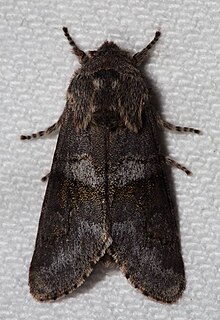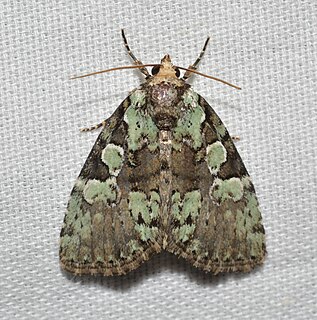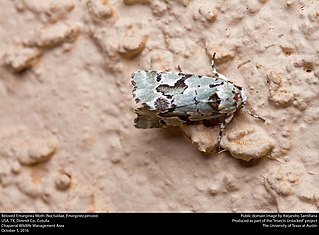
Acronicta is a genus of noctuid moths containing about 150 species distributed mainly in the temperate Holarctic, with some in adjacent subtropical regions. The genus was erected by Carl Linnaeus in his 1758 10th edition of Systema Naturae. Caterpillars of most Acronicta species are unmistakable, with brightly colored hairy spikes, and often feed quite visibly on common foliate trees. The hairy spikes may contain poison, which cause itchy, painful, swollen rash in humans on contact. The larva of the smeared dagger moth is unusually hairy even for this genus. Acronicta species are generally known as dagger moths, as most have one or more black dagger-shaped markings on their forewing uppersides. But some species have a conspicuous dark ring marking instead.

Copivaleria is a monotypic moth genus of the family Noctuidae erected by Augustus Radcliffe Grote in 1883. Its only species, Copivaleria grotei, or Grote's sallow, was first described by Herbert Knowles Morrison in 1874. It is found in eastern North America, including Ontario, Tennessee, New York and Maryland.

Feralia is a genus of moths of the family Noctuidae. The genus was erected by Augustus Radcliffe Grote in 1874.
Psaphida is a genus of moths of the family Noctuidae. The genus was erected by Francis Walker in 1865.

Psectraglaea is a monotypic moth genus of the family Noctuidae described by George Hampson in 1906. Its only species, Psectraglaea carnosa, the pink sallow, described by Augustus Radcliffe Grote in 1877, is native to North America. It is listed as threatened in Connecticut, and as a species of special concern in Massachusetts.

Feralia comstocki, or Comstock's sallow, is a moth of the family Noctuidae. The species was first described by Augustus Radcliffe Grote in 1874. It is found in North America from the southern Appalachians north to the Maritime provinces, east across the southern boreal forest to Vancouver Island, south to Oregon. In Alberta, the species has been collected from the Lake Athabasca and Zama areas south to about Pigeon Lake.

Psaphida styracis, the fawn sallow, is a moth of the family Noctuidae. The species was first described by Achille Guenée in 1852. It is found in the eastern parts of North America, and has been imported to the United Kingdom.

Psaphida thaxteriana is a moth of the family Noctuidae first described by Augustus Radcliffe Grote in 1874. It is found in the eastern parts of North America, including Tennessee and Maryland.

Psaphida electilis, the chosen sallow, is a moth of the family Noctuidae. The species was first described by Herbert Knowles Morrison in 1875. It is found in North America from Quebec and Ontario to Florida, west to Texas and Wisconsin.

Psaphida grandis, the gray sallow, is a moth of the family Noctuidae. The species was first described by John Bernhardt Smith in 1898. It is found in North America from Ontario, south to Florida. It has been recorded from Iowa, New York, Maryland, South Carolina, Arkansas, Michigan and Wisconsin.

Psaphida resumens, commonly named the figure-eight sallow, is a species of moth of the family Noctuidae. It is found from southern Ontario and Massachusetts to Florida, west to Texas, north to Minnesota.

Leuconycta lepidula, the marbled-green leuconycta moth, marbled-green jaspidia or dark leuconycta, is a moth of the family Noctuidae. The species was first described by Augustus Radcliffe Grote in 1874. It is found in North America from Nova Scotia to North Carolina, west to Texas and north to Alberta.

Epiglaea decliva, the sloping sallow moth, is a moth of the family Noctuidae. It is found in North America, where it has been recorded from Quebec and Maine to South Carolina, west to Kansas and north to Alberta. The habitat consists of barrens, thickets, woodlots and forests.
Epiglaea apiata, the pointed sallow moth or cranberry blossom worm, is a moth of the family Noctuidae. It is found in North America, where it has been recorded from Florida, Georgia, Indiana, Louisiana, Maine, Maryland, Michigan, Minnesota, New Brunswick, North Carolina, Ohio, Quebec, South Carolina and Wisconsin.

Eupsilia vinulenta, the straight-toothed sallow moth, is a moth in the family Noctuidae described by Augustus Radcliffe Grote in 1864. It is found in North America.

Pyreferra ceromatica, the anointed sallow moth, is a species of moth native to North America. In the US state of Connecticut it is listed as a species of special concern and is believed to be extirpated. It was described by Augustus Radcliffe Grote in 1874.
Noctuini is a tribe of owlet moths in the family Noctuidae. There are at least 520 described species in Noctuini.

Psaphidini is a tribe of owlet moths in the family Noctuidae. There are at least 40 genera and at least 90 described species in Psaphidini.
Chaetaglaea fergusoni, or Ferguson's sallow moth, is a moth in the family Noctuidae. It was described by Vernon Antoine Brou Jr. in 1997 and is found in North America.

Lithophane grotei, commonly known as Grote's pinion or Grote's sallow, is a species of moth in the family Noctuidae. It was first described by Riley in 1882 and it is found in North America.












